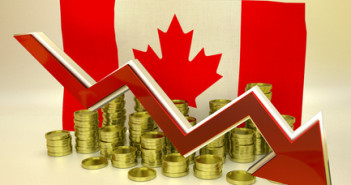Bank of Canada Limits Loonie Upside, Oil Only Saving Hope for Bulls
The Government of Canada has confirmed the dampening of the Canadian dollar rally by maintaining the overnight target rate at .75% and also specifically mentioning the impact of the Canadian dollar in its release. The specific mention of the Canadian dollar in its release reiterates the Bank of Canada preferring a weak loonie and also limits Canadian dollar upside as they may talk down any rising Canadian dollar in the future.
Although oil prices have rallied and have slightly propped up the Canadian dollar on a softer US dollar a few weeks ago, there is still no sure sign as to the long-term direction or expectation for oil prices. While oil inventories in the US are growing at a much slower rate than in recent months, there is still threat from oil players overseas, namely OPEC’s Iraq, that threaten to increase oil supplies which can send oil prices back down. However, planned crude exports and actual crude exports from the country are often delayed and may not play as a factor until the second half of the fiscal year. Another sign that supplies may be back on the rise is the rising price of oil storage which is at its highest level for this time of year since 2008.
This implies that Canada will likely have to rely heavily on other aspects of the economy to maintain inflation targets and to meet necessary economic growth to mitigate financial instability. With household consumption remaining relatively stable, the driving aspects of the economy will be mainly exports and foreign business investment as indicated by the Bank of Canada. However, these two factors hinge mainly on Canada’s biggest trade partner the US, and its respective economic conditions as well as dollar strength. As a result, all eyes are on the US economy and future related data releases.
US Q1 results were seen as a write off due to poor weather conditions and west coast port strikes; however, that has put more pressure on Q2 and subsequent quarter results. If results end up in line with expectations of a strong Q2, an even stronger US dollar can be expected. As a result, a strengthening US dollar and a low Canadian dollar will result in higher exports and business investment in Canada. A strengthening of the US economy may also result in a decrease in current interest rate differentials if the Fed raises interest rates which can further suppress the Canadian dollar and fuel the Canadian economy towards the end of the fiscal year.
In the case that the US does not deliver strong economic results in Q2 and subsequent quarters, Canada may face the risk of further rate cuts as seen in January 2015. The rate cuts in January 2015 were seen as more of an “insurance” play which has helped maintain economic growth and allowed the necessary sectoral adjustments to boost investment and growth. However, with global economic growth relatively weak, a combination of persistent low oil prices and weak US economic growth could be catastrophic to Canada’s hopes to return the Canadian economy to full capacity and to meet inflation targets within projection horizons.
Moreover, the Bank of Canada seems in no rush at all to move on interest rates. In fact, it prefers to benefit from a stronger US economy for some time. A low Canadian dollar helps the case. With the Bank of Canada mentioning the impact of the Canadian dollar on growth and exports in its recent release, it only indicates the Bank of Canada is ready to talk down the Canadian dollar if it rises significantly. In essence, the Bank of Canada is limiting Canadian dollar upside and only rising oil prices could be the Canadian dollar’s saving hope.
By: Rahim Madhavji is the President of Knightsbridge Currency Exchange Toronto, a currency exchange company. Mr. Madhavji has been featured on BNN TV and the Globe and Mail.
